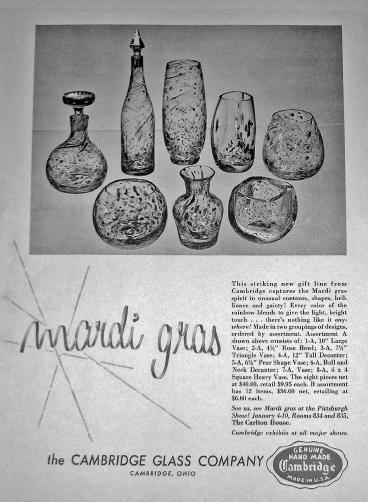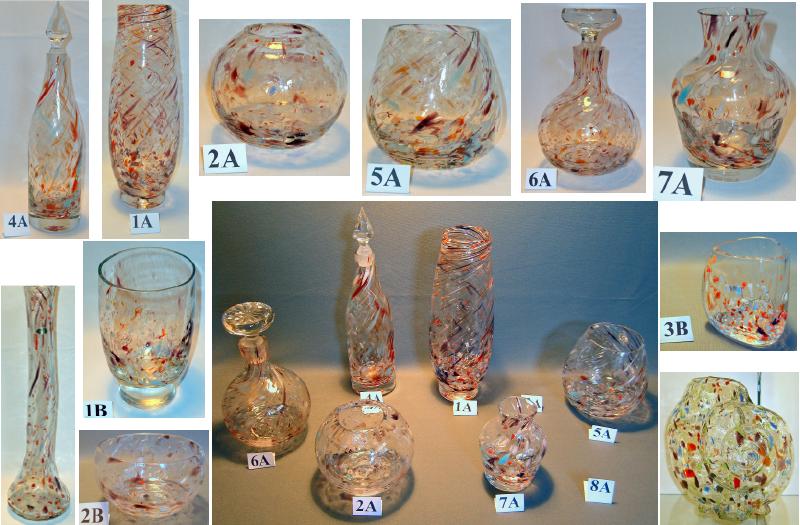Cambridge Mardi Gras
By Frank Wollenhaupt
Issue No. 420 - August 2008
This month I thought we would talk about "Mardi gras". I thought I would go to one of the catalogues, pull up some information, put
my spin on it, add a few photos and be done with it. Guess what, not much is published about Mardi gras so I have had to do some
digging. While digging, I started to do some thinking (that's dangerous) about what the company was going through at this time and
 what the rest of the glass industry was experiencing.
what the rest of the glass industry was experiencing.
First off, Mardi gras was introduced to the public in December 1957. It could have come out a month or so before this but the first time we can find it advertised was a full page ad shown in the December 1957 issue of "China, Glass and Lamps", page 37. It also makes an appearance in the 1958 Cambridge price book, page 12.
If we look at the shapes used in making Mardi gras and take a close look at the glass itself, we find it is like nothing Cambridge has made in the past. I know some of you are jumping at that statement. Yes, I am aware of "White Rain" and "Blue Cloud" that were introduced in 1956. I believe that was the start of the Mardi gras line and they were just testing the waters.
As I said, Mardi gras was like nothing else Cambridge has ever made. The pieces are heavy, the shapes are close to free form, and they don't carry the etchings or decorations that had made Cambridge a leader in the glass industry. They are as much NON Cambridge as anything ever made. If we take this time and look at what the rest of the industry was making, we find Blenko Glass Company, Rainbow Glass, Bischoff, Kanawha, Erickson and Fostoria doing some of the same type of things. We can also list many import items that have the same feel and look. If we add all this outside pressure from the rest of the glass industry along with the pressure from just reopening we have a glass company that is trying to recapture its place in the American Hand Made Glass industry.
Just what is Mardi gras and how is/was it made? All the items to date with one or two exceptions are blown. The glass worker would take his blow pipe and get a nice gather of crystal glass on the end of the pipe. He would then take it to the marver (large metal plate) and roll or flatten the gather to get it into the shape he needed for the mold he was working. He would then take this shape back to the glory hole to re-heat it. At this time another worker would have prepared a batch of fritt (a bunch of rough ground colored glass) and had it spread out on another marver. The glass worker would take his shaped gather of glass over to the fritt and roll it in the glass chunks. The colored glass chunks would stick to the crystal gather (this is the color we see in the Mardi Gras). The glass worker would now take the gather, with the frit attached, over to the crystal tank and apply another gather of crystal glass to the outside. He has now sandwiched the glass chunks (fritt) between two gathers of crystal glass. At this time, he could go back to the marver and further shape the gather so it is ready to be blown into the mold or back to the glory hole to get some additional heat before he attempts to blow the item.
If you own a piece of Mardi gras or have the opportunity to examine a piece, feel both the inside and the outside of it. You should be able to feel some of the chunks of glass. Notice the trapped air bubbles and you might even see some fine cracking around the fritt inside the glass.
When the line was introduced, it consisted of 16 items. Most of the items are pictured on the following page and are identified below. These 16 items were divided up into two assortments – "A" assortment consisted of:
- 1A-10" Large Vase
- 2A-4½" Rose Bowl
- 3A-7½" Triangle Vase
- 4A-12" Tall Decanter
- 5A-6½" Pear Shape Vase
- 6A-Ball and Neck Decanter
- 7A-Vase
- 8A-4 x 4 Square Heavy Vase
and "B" assortment consisted of:
- 1B-Small Vase
- 2B-Shallow small Bowl
- 3B-(2ea)Triangle Vase
- 4B-Flip Vase
- 5B-(2ea)Shallow Bowl-Ash Tray
- 6B-(2ea)Rose Bowl
- 7B-Flip Vase
- 8B-(2ea)Ash Tray heavy
Assortment "A" had a cost of $40.00 ($5.00 per item) and assortment "B" had a cost of $36.00 ($3.00 per item). The suggested list price of each item was $10.00 each for the "A" items and $6.00 for each of the "B" items. Don't we all wish we could find a few of those assortments sitting around someplace? I doubt if anyone would even ask for a discount.
We are fortunate that part of the full page ad was a photo of the "A" assortment. I have provided a copy of this ad; hopefully it will reprint well enough for identification of the items. After seeing what the large assortment looks like, we can then try and guess what the "B" or smaller assortment would look like.
With the above list documented from the ad and also the price list I wonder about the one of a kind items, lunch box specials or trial items. We know of several pieces in the museum that are probably one of a kind, like the #46 – 7½" Sea Shell flower holder and the #33 – 4" Sea Shell ash tray. I also wonder about the 17"/18" tall vase. It isn't one of the listed items from production but 3 or 4 of them have been found. What about you, do you have something not listed as part of assortment "A" or "B"? Let us know.
While doing the research, I also tried to find some of the shapes/molds that were used to put this line together. I believe that they chose molds that have been used for many different things and put them all together to make this line. I found that they used a lot of the Pristine molds to make up this line. The #588-11" vase looks like the 1-A, 10" Large Vase. The #402-4½" ball vase looks like the 2-A, 4½" rose Bowl. The stopper for the 6-A Ball and Neck decanter is from the P-62 Pristine 26oz decanter and the pointed stopper in the 4-A 12" Tall Decanter is from the Pristine #90 tall 28oz decanter.

If you look close, you can also see that they used one of the larger items and cut it down to make one or more of the smaller items. I believe that this was an economical way for the company to save production. If it started out as a decanter and some of the fritt chipped at the top, cut it down and make one of the larger bowls. Because this is such a small line and because it happened late in the life of the Cambridge factory, we have a chance to put together a list of what items are out in collections. If anyone has a piece or several pieces of Mardi gras in your collection, take a photo of it/them and send it to me. Please include measurements of the items. Let's see what we can come up with. I will share my findings but not your name or location. Enjoy the photos and I hope to hear from you about your collection. Email Frank at fewvic303@sbcglobal.net.
